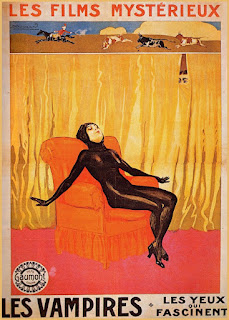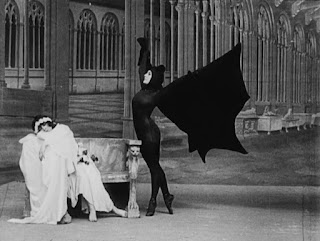 |
| Image credit: IMDb |
It’s most interesting to go back in time and pinpoint where certain trends and fashions began, especially in cinema. With films being churned out faster and faster nowadays thanks to the pandemic and the need for new and original streaming service content, the industry has been put into a somewhat higher gear. But it’s important to remember that even though the world is moving so fast in terms of producing content for us to consume, we can always choose to slow down and go at out own pace: like I did with Louis Feuillade’s fascinating 1915 movie serial, Les Vampires.
This long film, segmented into ten chapters of varying lengths, tells the story of a Parisian crime gang called the Vampires and their eventual takedown by an ambitious journalist (Edouard Mathe) and his comedic sidekick (Marcel Levesque). Kidnapping, murder, and mayhem abound with each chapter telling a different, smaller story that makes up a grand, epic vendetta.
Les Vampires is an original in so many ways. Definitely not a film you can do in one sitting, its segmented form is perfect for a balanced cinematic experience of intermissions and breathers in which to catch up on what’s just happened. This also gives us time to appreciate just how influential a historical piece it is. It’s the first thriller, the first example of cinematic noir and the surrealist movement, as well as the first moving picture that delivers the exciting detective story (a la Sherlock Holmes) experience. Watching it is a bit like reading Sir Arthur Conan Doyle’s classic tales of the great detective, with the audience being privy to the tricks and traps of the villains while the hero is not.
As a representation of society and culture, Les Vampires is mightily clever, as it makes a point to show that good and evil is not always clear and distinct. While the Vampires themselves are merciless and manipulative with brutal means of executing their plans, they are not without their own system of law and government and indeed, at many points during the film the heroes plot and scheme in much the same fashion. This bleeding of the boundaries between good and evil is what makes the film so fascinating, more so considering the fact that the villains name themselves after the most celebrated of evil monsters.
 |
| Image credit: IMDb |
We then have the superb visual aspect of the film. While the footage itself is grainy and definitely dated, it does not take away from the fact that there are so many exciting visual treats, mostly to do with the more action-y sequences and sinister stealth plots. Considering this was made in 1915, the set designs are incredible with elaborate trap doors, tricks walls, and sliding panels that would put the castle of Otranto to shame! At one point an entire canon comes sliding out of a wall to fire at a nearby cabaret! Then there are some of the greatest chase sequences I’ve ever seen. The Vampires main mode of travel is shimmying up and down drainpipes, scaling walls, and darting from rooftop to rooftop, which makes for very exciting chases when the good guys get on their tail. We’ve got people being thrown from rooftops into moving cars, people spinning down Cirque du Soleil style to make quick getaways, and enough many nooks and hidey-holes to turn Parisian apartments into Swiss cheese.
Les Vampires is a stretch, admittedly to sit down and commit to, but one that it worth the investment, especially if you’re as interesting in film history as I am.
Director: Louis Feuillade, 1915
Cast: Edouard Mathe, Musidora, Marcel Levesque, Jean Ayme, Fernand Herrmann & Stacia Napierkowska
No comments:
Post a Comment